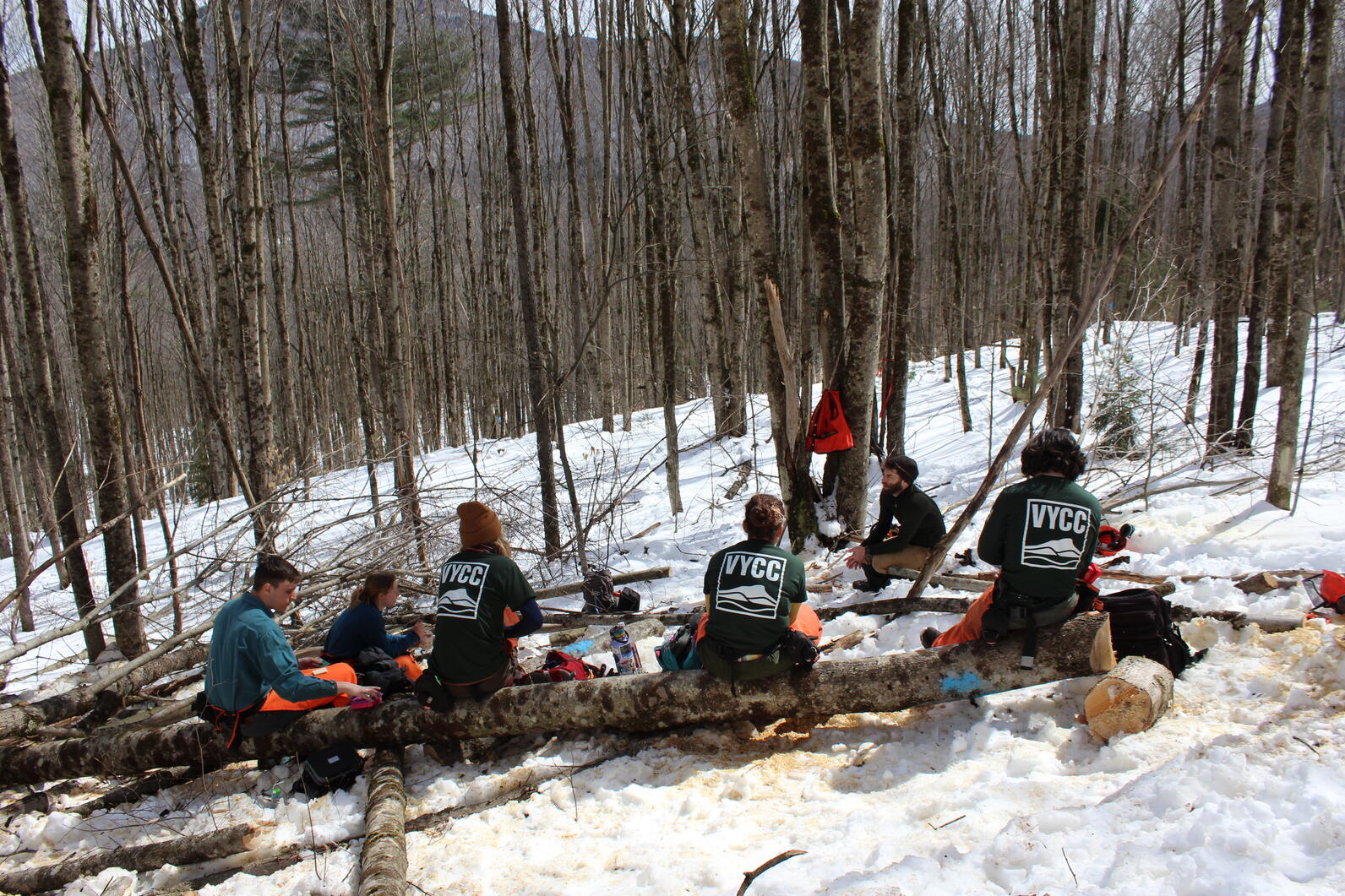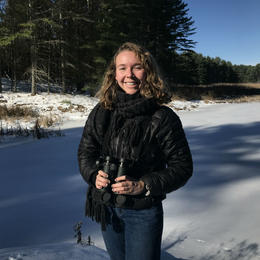It’s always a treat to see ideas written on paper come to life, which is why I take any chance I get to head out into the field to better understand how our partnerships work on the ground especially when there is a youth leadership component.
So when an opportunity arose to join Tim Duclos, Audubon Vermont’s Forest Program Senior Associate, to visit a landowner property in Belvidere where we are working collaboratively with Cold Hollow to Canada (CHC) and Vermont Youth Conservation Corps (VYCC) I was all in.
First, some context! Over the last four years, Audubon Vermont (through our Woods, Wildlife and Warblers(WWW) program) and CHC have worked together to provide forest bird habitat assessments, at no charge, to members of CHC’s Woodlots Program; we also offer these services state-wide through our WWW program. The Woodlots Program encourages landowners with contiguous forested properties to collaborate on forest management plans so that their impact increases from a single property to a landscape scale. Contiguous forests are crucial for wildlife movement and ecosystem health.
Last summer, Tim and his forestry intern, Veronica, conducted forest bird habitat assessments for several properties in the CHC region, a region where the Cold Hollow Mountains stretch across seven towns in northern Vermont. According to CHC, “the Cold Hollow Mountains are part of the largest intact temperate forest left in the world: the Northern Forest, stretching across the northeastern United States and southeastern Canada. From Massachusetts to Quebec, the Northern Forest encompasses nearly 82 million acres and is inhabited by 470 vertebrate species, 2,700 plant species, and 5 million people.” As such, it is an important area to protect and continue to enhance wildlife habitat. Those recommendations are then sent to CHC’s consulting forester who can decide with the landowners if they want to incorporate them into forest management plans.
So what follows after forest management plans are made? Implementation! Thanks to a generous grant from the Sarah K. de Coizart Perpetual Charitable Trust that was distributed by the Northeast Bird Habitat Conservation Initiative Audubon Vermont was able to team up with Nancy Patch, (Franklin/Grand Isle County Forester for the Vermont Department of Forests, Parks, and Recreation and Vice Chair and Co-Founder of Cold Hollow to Canada, Charlie Hancock, Audubon Vermont Endorsed Forest, and VYCC to remediate forested areas enrolled in the CHC Woodlots Program for biodiversity and bird habitat at four abutting properties. Charlie is the forest for the landowner, Nancy marks trees for harvest, and then VYCC sends crews to remove the trees.
This background finally brings us to my adventure into the woods with Tim. I left my desk to drive up to Belvidere to meet with VYCC’s year-round crew leaders who are early career professionals with backgrounds steeped in conservation corps work from around the country. With their new chainsaw certifications, these were the folks carrying out the work prescribed in the forest management plans.
When we arrived, two leaders Hank and Katie led us up a snowy, winding path through the woods to the stand (a group of trees comprising a unique forested area)- where they were currently working. Along the way we pass stands they have already worked on this week. Orange and pink flagging tape speckled throughout the woods and messy piles of branches that had once been canopy lay on the forest floor - perfect habitat for the Ovenbird and other ground nesters! In other words, messy is good!

Over lunch, Tim talked about the importance of structural diversity and biodiversity in the forest. He explained that birds are an indicator species for ecosystem health and thus a great species to manage for. Put simply, what’s good for the birds is good for the ecosystem and wildlife at large. A Brown Creeper and White-breasted Nuthatch interrupted his lecture as if saying thank you on cue. At this stand, the crew leaders were cutting single trees down, singly and in groups, to promote better growth of remaining mature trees and to create a gap in the canopy to allow sunlight to reach the struggling saplings and encourage regenerative growth of red spruce. Other prescriptions on the property included leaving logs and treetops on the ground to create coarse and fine woody material as well as snag (standing dead tree) creation through girdling.
After lunch, I took a few minutes to get to know these new year-round crew leaders. Over the next few months they would learn the ins and outs of VYCC and then lead crews of young people all over the state in forestry, trails, and water quality work. Many of them are interested in pursuing careers in wildlife biology and conservation. One told me that she hopes to join a wildfire crew out west after this job, while another shared that they wanted to go into environmental nonprofit administration. At one point, Katie shared that every student should be made aware of AmeriCorps, Conservation Corps, and other similar programs as it is a great introduction to the workforce and could be a the first step into a field you'd like to go into. I'll likely get to interact with some of these crew leaders over the summer. Audubon and VYCC are close partners in many ways, but mainly through our workforce collaborative with two other Vermont nonprofits, Vermont Works for Women and ReSource, called Serve Learn Earn. Through this collaborative, the four organizations provide Vermonters with more opportunities to gain important skills, give back to the community, and earn compensation while they work toward a rewarding career. In the spirit of collaboration and sharing our work between organizations, I'll be joining VYCC Youth Crews this summer out in the field to talk about how their work positively impacts bird habitat as well as an introduction to bird ID so crew members can start recognizing the birds they see during work.
Decked out in a safety helmet and ear protection, I took action shots while the crew leaders used their new chainsaw skills. I watched as one leader created a back cut in a sugar maple and then used wedges to topple the tree over exactly where she wanted it to land. As she made her cuts maple sap drenched her chaps. It was amazing to watch this tree, probably around 50 years old, make its swift decent to the forest floor where it would be used for habitat until it returns to the earth.
I left feeling energized and excited about our work and partnerships.







